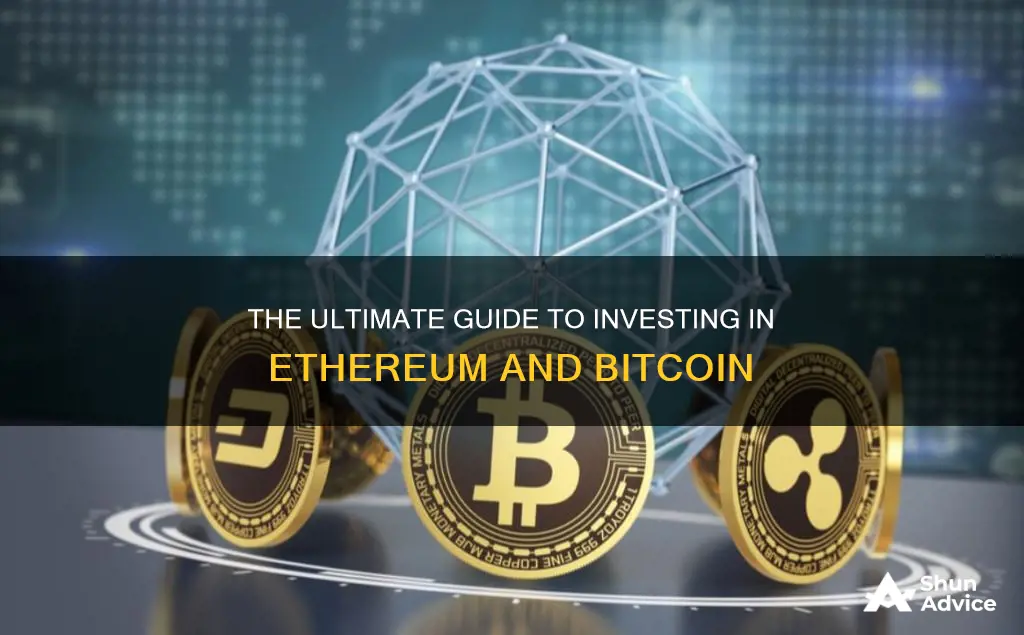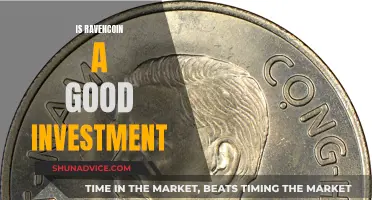
Investing in cryptocurrencies like Bitcoin and Ethereum is a hot topic. Both are cryptocurrencies with plenty in common, but there are also some fundamental differences. Bitcoin is the most highly valued and recognised cryptocurrency, created in 2009 by Satoshi Nakamoto. It is a simple digital payment method that does not require a central authority. On the other hand, Ethereum is the second-largest cryptocurrency and is considered the most popular altcoin. It is a complex network that supports a wide range of financial services and applications. Both have their unique features, and investors need to understand these differences to make informed decisions about their investment strategies.
| Characteristics | Values |
|---|---|
| Purpose | Bitcoin was designed as a way to carry out payments, while Ethereum can support more complex software. |
| Market Value | As of May 2024, Bitcoin's market cap was $1.3 trillion, while Ethereum's was $420 billion. |
| Investment | Both Bitcoin and Ethereum are volatile investments. In the past year, Bitcoin prices are up 157% compared to a 100% gain for Ether. |
| Buying Platforms | Coinbase, Gemini, eToro, Kraken, Binance, Robinhood, PayPal, Uphold, etc. |
| Storage | Hot wallets and cold wallets. |

Choosing a platform
There are several platforms to choose from when investing in Ethereum and Bitcoin. Coinbase is recommended by many sources, as it is free, has a great app, and offers a bonus of $5 for opening a new account and making your first trade. Coinbase also allows you to invest in other cryptocurrencies such as Litecoin. Other popular platforms include Gemini, Uphold, Binance, eToro, and Kraken.
When choosing a platform, it is important to consider the type of exchange. Cryptocurrency trading platforms can be centralized or decentralized. Centralized exchanges (CEXs) are usually businesses that store user keys, provide order-matching services, and charge fees for their services. Decentralized exchanges (DEXs), on the other hand, connect users who rely on smart contracts to execute trades, and users maintain control of their keys and wallets.
Another factor to consider is the credibility and security of the platform. Ask yourself questions such as where the platform is headquartered, whether it has a license, how secure its website and your funds are, and who the managing executives are. It is also important to ensure that the platform offers the cryptocurrency you want to invest in, as not all platforms offer both Ethereum and Bitcoin.
Additionally, consider the fees associated with each platform. Cryptocurrency exchanges typically charge fees per trade, so it is often more cost-effective to trade large amounts at once. Compare the fees across different platforms to find the most suitable option for you.
JPMorgan's Bitcoin Investment: Exploring the Giant's Crypto Move
You may want to see also

Opening an account
To open an account to invest in Ethereum or Bitcoin, you'll need to follow a few steps. Firstly, you'll need to choose a platform that suits your needs. Some popular options include Coinbase, Kraken, Gemini, Binance, Bitfinex, and Bitstamp. You can also use PayPal or Robinhood to buy Ethereum. When choosing a platform, consider factors such as the type of exchange (centralized or decentralized), security, and the credibility of the platform.
Once you've identified a suitable platform, the next step is to create an account. This process is similar to opening a brokerage account, and you'll need to provide personal information such as your name, address, social security number, and specified forms of identification. Most exchanges will also require you to verify your account, which may include uploading documents. This step is important to ensure the security of your funds and comply with regulatory requirements.
After your account is set up and verified, you'll need to deposit funds into your account to make your first purchase. You can typically use a bank account or a debit card for this step. It's important to note that cryptocurrency exchanges usually charge fees per trade, so it's often more cost-effective to trade larger amounts at once.
With your account funded, you're now ready to start purchasing or trading Ethereum and Bitcoin. Each exchange will have its own interface, so take some time to familiarize yourself with the platform. Remember that the processing time for transactions can vary depending on the number of requests.
Finally, once you've made your purchases, consider withdrawing your cryptocurrency to a wallet that you control. This step is especially important if you're using a centralized exchange, as it gives you full control over your private keys and adds an extra layer of security. You can use either a hot wallet or a cold wallet for storage. A hot wallet is an online wallet connected to the internet, while a cold wallet is offline and considered more secure.
The Rich and Bitcoin: A Lucrative Investment Strategy?
You may want to see also

Payment methods
There are several payment methods available when investing in Bitcoin or Ethereum. The most common way is to use a cryptocurrency exchange, such as Coinbase, Kraken, Gemini, or Binance. These exchanges allow you to connect your bank account directly or link a debit or credit card. However, it is important to note that fees vary for deposits and transactions, and some exchanges may charge higher fees for certain payment methods. Additionally, using a credit card to purchase cryptocurrency can result in higher overall costs due to the combination of transaction fees and credit card interest charges.
Another option is to use a payment processor like PayPal to buy Bitcoin. PayPal allows you to connect your bank account or debit card, or you can use your PayPal account balance to purchase cryptocurrencies directly. It is important to note that PayPal charges a transaction fee for each purchase, which varies depending on the amount bought.
For Ethereum specifically, you can also use a decentralized exchange (DEX) like Uniswap, 1inch, Bancor, or Kyber. These DEXs allow you to trade digital assets without giving control of your funds to a centralized company. However, DEXs are more technical and may be confusing for beginners.
Lastly, you can also purchase Bitcoin and Ethereum through specialised ATMs or via peer-to-peer (P2P) exchanges, although these methods may have higher fees compared to other options.
A Beginner's Guide to Investing in Bitcoin (NZ)
You may want to see also

Making a purchase
There are several ways to buy Bitcoin and Ethereum. You can use a cryptocurrency exchange, a payment processor like PayPal, or a mainstream brokerage firm like Robinhood or Coinbase.
Using a cryptocurrency exchange
First, you will need to choose a crypto-trading service or venue. Popular exchanges in the U.S. include Coinbase, Kraken, Gemini, and Binance. When creating an account, use two-factor authentication and a long, unique password.
Next, connect your exchange to a payment option. You can link your bank account directly or use a debit or credit card.
Then, place an order. Cryptocurrency exchanges offer several order types and ways to invest, including market and limit orders, and sometimes stop-loss orders.
Finally, ensure safe storage for your purchased cryptocurrency. You can use a hot wallet (an online wallet, such as an app on your phone or computer) or a cold wallet (an offline wallet, such as a hardware device or paper printout).
Using PayPal
You can buy Bitcoin and Ethereum directly through PayPal. You can connect your PayPal account to a debit card or bank account, or you can use your PayPal balance to purchase crypto from a third-party provider.
Using a mainstream brokerage firm
Robinhood and Coinbase are examples of mainstream brokerage firms that offer crypto trading.
Institutional Bitcoin Adoption: Who's In and Why?
You may want to see also

Safe storage
Once you have purchased your Bitcoin or Ethereum, you will need somewhere safe to keep it. Most crypto investors leave their crypto on the exchange where they bought the asset. These exchanges provide free hot wallets with little or no setup required, but you’ll need an account with the exchange to gain access to these wallets.
Hot wallets are software that stores your keys and have connections to the internet. While a hot wallet is how most users access and make transactions in bitcoin, they are vulnerable and can be hacked.
Cold storage (or offline wallets) is one of the safest methods for holding bitcoin, as these wallets are not accessible via the internet. Those interested in the safest storage should consider using a non-custodial cold hardware wallet for all of their long-term bitcoin and cryptocurrency storage.
When you purchase bitcoin, you're given ownership of the amount you bought. You're given two keys: a public key, which is your wallet address, and a private key, which allows you to access your bitcoin. This is the key you're storing and safeguarding.
There are generally two categories of storage: custodial and non-custodial, and four types of wallets: desktop, mobile, hardware, and web-based.
- Desktop wallet: A program that resides on your computer. Not the safest storage method.
- Mobile: A program that is hosted on a mobile device. Not very secure.
- Hardware: A device similar to a USB drive. Secure, depending on if it is connected and how it connects to another device.
- Web-based: A wallet that is hosted by a web service. Not secure, as you're letting someone else store your keys for you.
Whether a wallet is connected to or resides on the internet determines whether it is a hot or cold wallet.
Using a top-rated Bitcoin wallet with cold storage abilities can help increase your Bitcoin and crypto security.
A custodial wallet is managed by a third party, such as an exchange like Coinbase. In this arrangement, the custodian stores your private keys for you, guaranteeing their safety and sometimes providing insurance on holdings up to a certain amount.
Non-custodial wallets are those you use to store your keys with no one else involved. Non-custodial wallets can also be either hot or cold.
It's important to remember that Ether (ETH) is a currency, and should be treated as such by investors. You don't buy shares of Ether like you would stocks or ETFs. Instead, you are exchanging your dollars for Ether tokens. There are no dividends, no payouts.
Once you buy and invest in Ethereum (ETH), it's a good idea to pull your crypto off the exchange and store it in your own cryptocurrency wallet that you control. There are several reasons for this, and there are some cons as well.
The pros of storing your crypto in your own wallet are that you have full control of your money, and there are no fees or gas charges with moving your ETH.
The cons are that if you want to buy or sell more, you have an added step of either sending your ETH to an exchange to sell, or when you buy, you need to transfer it to your own wallet.
If you're storing your crypto in your own wallet, make sure to back up your entire bitcoin wallet early and often. In case of a computer failure, a history of regular backups may be the only way to recover the currency in the digital wallet. Make sure to include all the wallet.dat files and then store the backup at multiple secure locations (like on a USB, CD, or another removable device). Additionally, ensure you use a strong password on the backup and encrypt it.
Keep your software up to date. A wallet running on non-updated software can be a soft target for hackers. The latest version of wallet software will have updated definitions and fixes in place, thereby increasing the safety of your bitcoins. Consistently update your mobile device or computer operating systems and software to make your bitcoins safer.
The safest way to buy Ethereum is to use a centralized and regulated exchange. Once you make your purchase, the safest way to store your key(s) is to transfer them to your wallet and place them on a cold storage device.
Berkshire Hathaway's Take on Bitcoin Investments
You may want to see also
Frequently asked questions
To buy Ethereum, you need a digital wallet connected to a cryptocurrency exchange. You can use a platform such as Coinbase, Kraken, Gemini, Binance, Bitfinex, or Bitstamp. You will need to create an account, verify your identity, and deposit currency into your account to make a purchase.
You can buy Bitcoin through a cryptocurrency exchange such as Coinbase, Kraken, Gemini, or Binance, or through a payment processor like PayPal. You will need to connect your account to a payment option, place an order, and ensure safe storage for your purchased cryptocurrency.
Bitcoin was designed as a way to carry out digital payments, while Ethereum is a network that supports a complex financial ecosystem. Bitcoin uses an energy-intensive method of verifying transactions known as mining, while Ethereum uses a process called staking, which has fewer environmental effects. Ethereum fees also tend to be higher than those for Bitcoin.







